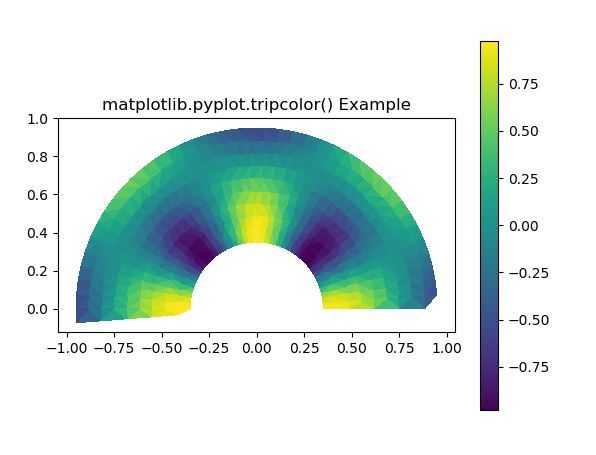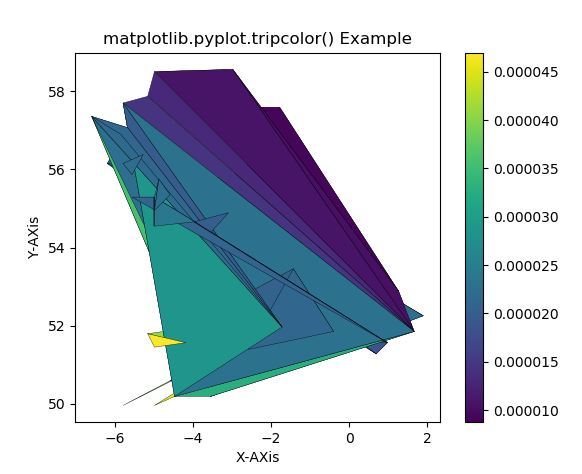Matplotlib是Python中的一个库,它是数字的-NumPy库的数学扩展。轴类包含大多数图形元素:Axis,Tick,Line2D,Text,Polygon等,并设置坐标系。 Axes实例通过callbacks属性支持回调。
matplotlib.axes.Axes.tripcolor()函数
matplotlib库的axiss模块中的Axes.tripcolor()函数还用于创建非结构化三角形网格的伪彩色图。
用法:
Axes.tripcolor(ax, *args, alpha=1.0, norm=None, cmap=None, vmin=None, vmax=None, shading=’flat’, facecolors=None, **kwargs)
参数:此方法接受以下描述的参数:
- x, y:这些参数是要绘制的数据的x和y坐标。
- triangulation:此参数是matplotlib.tri.Triangulation对象。
- **kwargs:此参数是文本属性,用于控制标签的外观。
其余所有args和kwargs与matplotlib.pyplot.plot()相同。
返回值:这将返回包含以下内容的2 Line2D的列表:
- 为三角形边绘制的线。
- 为三角形节点绘制的标记
以下示例说明了matplotlib.axes中的matplotlib.axes.Axes.tripcolor()函数:
示例1:
# Implementation of matplotlib function
import matplotlib.pyplot as plt
import matplotlib.tri as tri
import numpy as np
ang = 40
rad = 10
radm = 0.35
radii = np.linspace(radm, 0.95, rad)
angles = np.linspace(0, np.pi, ang)
angles = np.repeat(angles[..., np.newaxis],
rad, axis = 1)
angles[:, 1::2] += np.pi / ang
x = (radii * np.cos(angles)).flatten()
y = (radii * np.sin(angles)).flatten()
z = (np.sin(4 * radii) * np.cos(4 * angles)).flatten()
triang = tri.Triangulation(x, y)
triang.set_mask(np.hypot(x[triang.triangles].mean(axis = 1),
y[triang.triangles].mean(axis = 1))
< radm)
fig1, ax1 = plt.subplots()
ax1.set_aspect('equal')
tpc = ax1.tripcolor(triang, z,
shading ='flat')
fig1.colorbar(tpc)
ax1.set_title('matplotlib.pyplot.tripcolor() Example')
plt.show()输出:

示例2:
# Implementation of matplotlib function
import matplotlib.pyplot as plt
import matplotlib.tri as tri
import numpy as np
xy = np.asarray([
[-0.101, 0.872], [-0.080, 0.883],
[-0.069, 0.888], [-0.054, 0.890],
[-0.097, 0.975], [-0.092, 0.984],
[-0.101, 0.980], [-0.108, 0.980],
[-0.104, 0.987], [-0.102, 0.993],
[-0.115, 1.001], [-0.099, 0.996],
[-0.057, 0.881], [-0.062, 0.876],
[-0.078, 0.876], [-0.087, 0.872],
[-0.030, 0.907], [-0.007, 0.905],
[-0.057, 0.916], [-0.025, 0.933],
[-0.045, 0.897], [-0.057, 0.895],
[-0.073, 0.900], [-0.087, 0.898],
[-0.090, 0.904], [-0.069, 0.907],
[-0.069, 0.921], [-0.080, 0.919],
[-0.073, 0.928], [-0.052, 0.930],
[-0.048, 0.942], [-0.062, 0.949],
[-0.054, 0.958], [-0.069, 0.954],
[-0.087, 0.952], [-0.087, 0.959],
[-0.080, 0.966], [-0.085, 0.973],
[-0.087, 0.965], [-0.097, 0.965],
[-0.097, 0.975], [-0.092, 0.984],
[-0.101, 0.980], [-0.108, 0.980],
[-0.104, 0.987], [-0.102, 0.993],
[-0.115, 1.001], [-0.099, 0.996],
[-0.101, 1.007], [-0.090, 1.010],
[-0.087, 1.021], [-0.069, 1.021],
[-0.052, 1.022], [-0.052, 1.017],
[-0.069, 1.010], [-0.064, 1.005],
[-0.048, 1.005], [-0.031, 1.005],
[-0.031, 0.996], [-0.040, 0.987],
[-0.045, 0.980], [-0.052, 0.975],
[-0.040, 0.973], [-0.026, 0.968],
[-0.020, 0.954], [-0.006, 0.947],
[ 0.003, 0.935], [ 0.006, 0.926],
[ 0.005, 0.921], [ 0.022, 0.923],
[ 0.033, 0.912], [ 0.029, 0.905],
[ 0.017, 0.900], [ 0.012, 0.895],
[ 0.027, 0.893], [ 0.019, 0.886],
[ 0.001, 0.883], [-0.012, 0.884],
[-0.029, 0.883], [-0.038, 0.879],
[-0.073, 0.928], [-0.052, 0.930],
[-0.048, 0.942], [-0.062, 0.949],
[-0.054, 0.958], [-0.069, 0.954],
[-0.087, 0.952], [-0.087, 0.959],
[-0.080, 0.966], [-0.085, 0.973],
[-0.087, 0.965], [-0.097, 0.965],
[-0.077, 0.990], [-0.059, 0.993]])
x, y = np.rad2deg(xy).T
triangles = np.asarray([
[60, 59, 57], [ 2, 64, 3],
[ 3, 63, 4], [ 0, 67, 1],
[62, 4, 63], [57, 59, 56],
[59, 58, 56], [61, 60, 69],
[57, 69, 60], [ 4, 62, 68],
[67, 66, 1], [65, 2, 66],
[ 1, 66, 2], [64, 2, 65],
[63, 3, 64], [ 6, 5, 9],
[61, 68, 62], [69, 68, 61],
[ 9, 5, 70], [ 6, 8, 7],
[21, 24, 22], [17, 16, 45],
[20, 17, 45], [21, 25, 24],
[27, 26, 28], [20, 72, 21],
[25, 21, 72], [45, 72, 20],
[25, 28, 26], [44, 73, 45],
[72, 45, 73], [28, 25, 29],
[29, 25, 31], [43, 73, 44],
[73, 43, 40], [72, 73, 39],
[72, 31, 25], [42, 40, 43],
[31, 30, 29], [39, 73, 40],
[ 4, 70, 5], [ 8, 6, 9],
[56, 69, 57], [69, 56, 52],
[70, 10, 9], [54, 53, 55],
[56, 55, 53], [68, 70, 4],
[52, 56, 53], [11, 10, 12],
[69, 71, 68], [68, 13, 70],
[10, 70, 13], [51, 50, 52],
[13, 68, 71], [52, 71, 69],
[12, 10, 13], [71, 52, 50],
[71, 14, 13], [50, 49, 71],
[49, 48, 71], [14, 16, 15],
[14, 71, 48], [17, 19, 18],
[17, 20, 19], [48, 16, 14],
[48, 47, 16], [47, 46, 16],
[16, 46, 45], [23, 22, 24],
[42, 41, 40], [72, 33, 31],
[32, 31, 33], [39, 38, 72],
[33, 72, 38], [33, 38, 34],
[37, 35, 38], [34, 38, 35],
[35, 37, 36]])
xmid = x[triangles].mean(axis = 1)
ymid = y[triangles].mean(axis = 1)
x0 = -15
y0 = 12
zfaces = np.exp(-0.2 * ((xmid - x0) + (ymid - y0) ))
fig3, ax3 = plt.subplots()
ax3.set_aspect('equal')
tpc = ax3.tripcolor(x, y, triangles, facecolors = zfaces,
edgecolors ='k')
fig3.colorbar(tpc)
ax3.set_title('matplotlib.pyplot.tripcolor() Example')
ax3.set_xlabel('X-AXis')
ax3.set_ylabel('Y-AXis')
plt.show()输出:

相关用法
注:本文由纯净天空筛选整理自SHUBHAMSINGH10大神的英文原创作品 Matplotlib.axes.Axes.tripcolor() in Python。非经特殊声明,原始代码版权归原作者所有,本译文未经允许或授权,请勿转载或复制。
